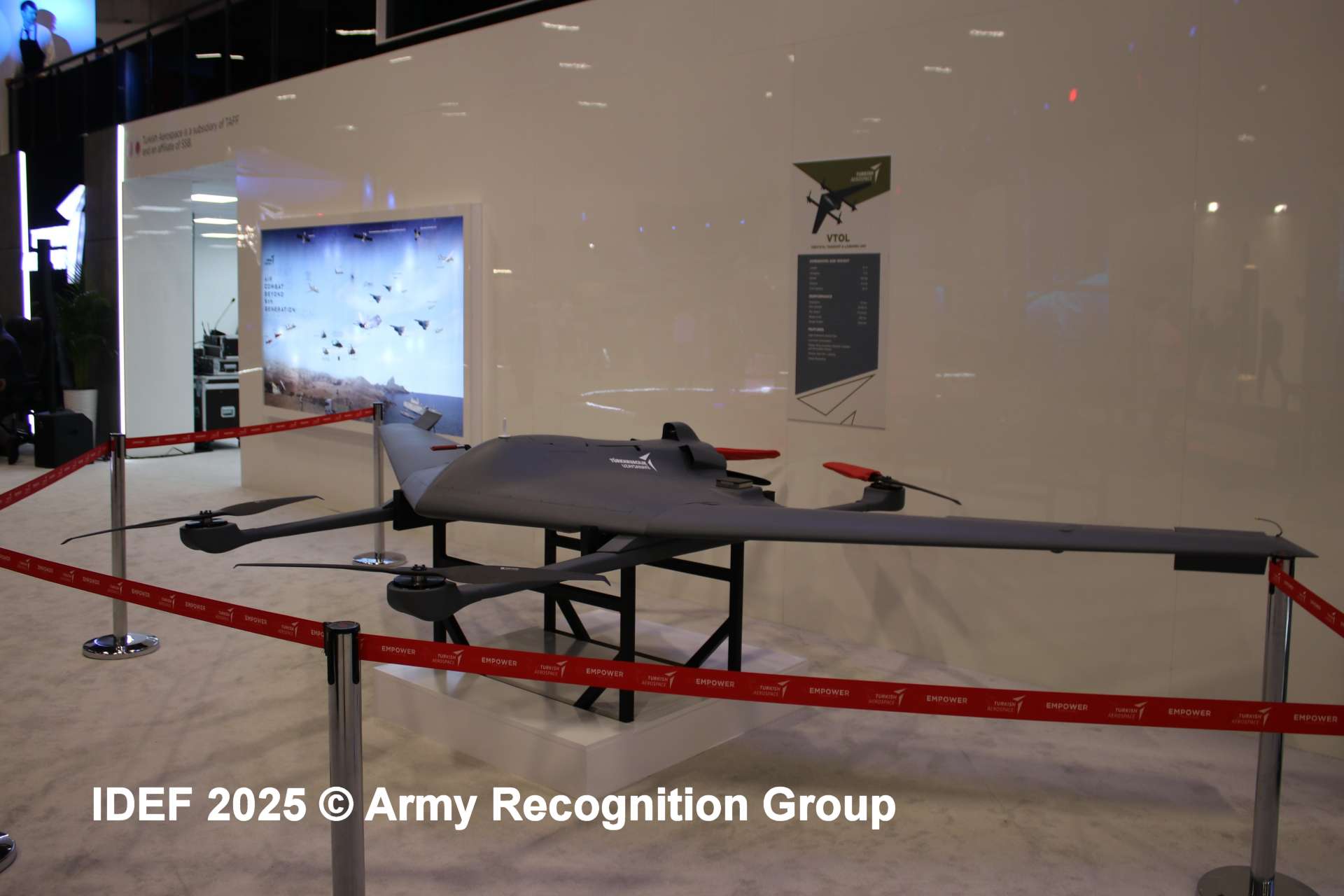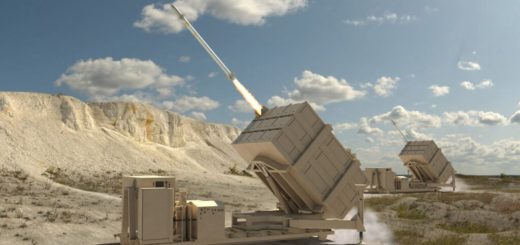Turkish Aerospace Industries Presents New VTOL Drone at IDEF 2025 Offering Long-Endurance Recon Capabilities for Strategic Missions

{loadposition bannertop}
{loadposition sidebarpub}
During the IDEF 2025 exhibition in Istanbul, Turkish Aerospace Industries (TAI) revealed its latest innovation in the unmanned aerial systems domain: a Vertical Take-Off and Landing (VTOL) UAV. Designed to respond to modern battlefield needs, this new platform promises enhanced flexibility and endurance in ISR operations. With rising global demand for high-endurance UAVs capable of operating in constrained environments, TAI’s unveiling signals a notable step in Türkiye’s growing UAV portfolio. Its design and features address operational challenges across varied terrains and missions, marking it as a key asset for near-peer and asymmetric conflicts alike.Follow Army Recognition on Google News at this link
TAI’s presentation of its VTOL UAV at IDEF 2025 underscores Türkiye’s ambition to bridge the gap between advanced drone technology and battlefield adaptability (Picture source: Army Recognition Group)
The newly presented VTOL UAV from TAI stands out through a compact yet capable design, integrating vertical lift capabilities with fixed-wing endurance. With a length of 3.1 meters and a wingspan of 5 meters, the platform achieves a maximum take-off weight of 120 kg and carries a payload of up to 2.5 kg. It features a fuel capacity of 60 liters, supporting a flight endurance of 10 hours and a maximum range of 1300 km. The UAV reaches altitudes of up to 9,000 feet with a top speed of 70 knots, while its operational control link is maintained up to 100 km. A mobile wing assembly enables rapid folding and disassembly, enhancing its deployability in the field.
The VTOL UAV represents a new phase in TAI’s broader UAV development strategy, rooted in decades of indigenous drone manufacturing experience. Drawing from earlier programs such as the Anka and Aksungur, this new system was likely conceived to address specific tactical demands arising from Türkiye’s ongoing counter-terrorism, border surveillance, and international peacekeeping roles. Its VTOL design, coupled with long-endurance characteristics, fills a known operational gap between compact rotary drones and large fixed-wing UAVs. The design phase seems to have integrated feedback from field units requiring low-maintenance aerial assets with rapid deployment capabilities in harsh or infrastructure-limited zones.
Compared to similar platforms such as the US-made Martin UAV V-BAT or Israel’s Urban Aeronautics AirMule, TAI’s VTOL UAV prioritizes fuel-based propulsion, delivering longer flight endurance and operational range while maintaining low fuel consumption. While electric VTOLs often suffer from range and endurance limitations, TAI’s system leans on conventional combustion fuel to bypass these constraints. The modular wing design adds logistical flexibility, allowing for rapid transport and reassembly, a feature not commonly found in many VTOL drones of similar scale. The design avoids the complexity of tilt-rotor mechanisms, favoring a simpler and potentially more robust lift-cruise configuration.
From a strategic standpoint, this VTOL UAV enhances Türkiye’s tactical ISR capacity in areas where infrastructure is compromised or non-existent. It offers capabilities suited for naval operations from small vessels, mountainous border surveillance, and remote operations in Africa or Central Asia where Turkish military and security cooperation efforts are expanding. Its capability to loiter for long durations without needing a runway gives Türkiye a distinct asset for persistent aerial surveillance and real-time situational awareness in contested or remote regions. It also fits well within NATO’s evolving drone integration frameworks, potentially making it attractive for allied partners.
As of IDEF 2025, no specific procurement contract was officially disclosed, though the platform’s features suggest it is being positioned for both domestic procurement by the Turkish Armed Forces and export markets. TAI has a proven track record in turning prototypes into frontline assets rapidly, with previous UAVs entering service within two years of unveiling. Given the increasing interest from African, Middle Eastern, and Central Asian states in flexible ISR drones, this VTOL system may soon secure a defense contract, likely from a customer seeking long-range surveillance without dependency on traditional airbase infrastructure. Budget-wise, this UAV falls into a category of cost-efficient tactical systems, avoiding the high price tags of larger MALE drones.
TAI’s presentation of its VTOL UAV at IDEF 2025 underscores Türkiye’s ambition to bridge the gap between advanced drone technology and battlefield adaptability. By combining vertical lift, long-endurance, and simplified mobility, this UAV addresses core tactical needs in modern military operations. Its introduction adds a flexible, scalable tool to the growing Turkish drone ecosystem and positions TAI to respond competitively in a global market increasingly shaped by asymmetric threats and modular defense technologies.
{loadposition bannertop}
{loadposition sidebarpub}
During the IDEF 2025 exhibition in Istanbul, Turkish Aerospace Industries (TAI) revealed its latest innovation in the unmanned aerial systems domain: a Vertical Take-Off and Landing (VTOL) UAV. Designed to respond to modern battlefield needs, this new platform promises enhanced flexibility and endurance in ISR operations. With rising global demand for high-endurance UAVs capable of operating in constrained environments, TAI’s unveiling signals a notable step in Türkiye’s growing UAV portfolio. Its design and features address operational challenges across varied terrains and missions, marking it as a key asset for near-peer and asymmetric conflicts alike.
TAI’s presentation of its VTOL UAV at IDEF 2025 underscores Türkiye’s ambition to bridge the gap between advanced drone technology and battlefield adaptability (Picture source: Army Recognition Group)
The newly presented VTOL UAV from TAI stands out through a compact yet capable design, integrating vertical lift capabilities with fixed-wing endurance. With a length of 3.1 meters and a wingspan of 5 meters, the platform achieves a maximum take-off weight of 120 kg and carries a payload of up to 2.5 kg. It features a fuel capacity of 60 liters, supporting a flight endurance of 10 hours and a maximum range of 1300 km. The UAV reaches altitudes of up to 9,000 feet with a top speed of 70 knots, while its operational control link is maintained up to 100 km. A mobile wing assembly enables rapid folding and disassembly, enhancing its deployability in the field.
The VTOL UAV represents a new phase in TAI’s broader UAV development strategy, rooted in decades of indigenous drone manufacturing experience. Drawing from earlier programs such as the Anka and Aksungur, this new system was likely conceived to address specific tactical demands arising from Türkiye’s ongoing counter-terrorism, border surveillance, and international peacekeeping roles. Its VTOL design, coupled with long-endurance characteristics, fills a known operational gap between compact rotary drones and large fixed-wing UAVs. The design phase seems to have integrated feedback from field units requiring low-maintenance aerial assets with rapid deployment capabilities in harsh or infrastructure-limited zones.
Compared to similar platforms such as the US-made Martin UAV V-BAT or Israel’s Urban Aeronautics AirMule, TAI’s VTOL UAV prioritizes fuel-based propulsion, delivering longer flight endurance and operational range while maintaining low fuel consumption. While electric VTOLs often suffer from range and endurance limitations, TAI’s system leans on conventional combustion fuel to bypass these constraints. The modular wing design adds logistical flexibility, allowing for rapid transport and reassembly, a feature not commonly found in many VTOL drones of similar scale. The design avoids the complexity of tilt-rotor mechanisms, favoring a simpler and potentially more robust lift-cruise configuration.
From a strategic standpoint, this VTOL UAV enhances Türkiye’s tactical ISR capacity in areas where infrastructure is compromised or non-existent. It offers capabilities suited for naval operations from small vessels, mountainous border surveillance, and remote operations in Africa or Central Asia where Turkish military and security cooperation efforts are expanding. Its capability to loiter for long durations without needing a runway gives Türkiye a distinct asset for persistent aerial surveillance and real-time situational awareness in contested or remote regions. It also fits well within NATO’s evolving drone integration frameworks, potentially making it attractive for allied partners.
As of IDEF 2025, no specific procurement contract was officially disclosed, though the platform’s features suggest it is being positioned for both domestic procurement by the Turkish Armed Forces and export markets. TAI has a proven track record in turning prototypes into frontline assets rapidly, with previous UAVs entering service within two years of unveiling. Given the increasing interest from African, Middle Eastern, and Central Asian states in flexible ISR drones, this VTOL system may soon secure a defense contract, likely from a customer seeking long-range surveillance without dependency on traditional airbase infrastructure. Budget-wise, this UAV falls into a category of cost-efficient tactical systems, avoiding the high price tags of larger MALE drones.
TAI’s presentation of its VTOL UAV at IDEF 2025 underscores Türkiye’s ambition to bridge the gap between advanced drone technology and battlefield adaptability. By combining vertical lift, long-endurance, and simplified mobility, this UAV addresses core tactical needs in modern military operations. Its introduction adds a flexible, scalable tool to the growing Turkish drone ecosystem and positions TAI to respond competitively in a global market increasingly shaped by asymmetric threats and modular defense technologies.






